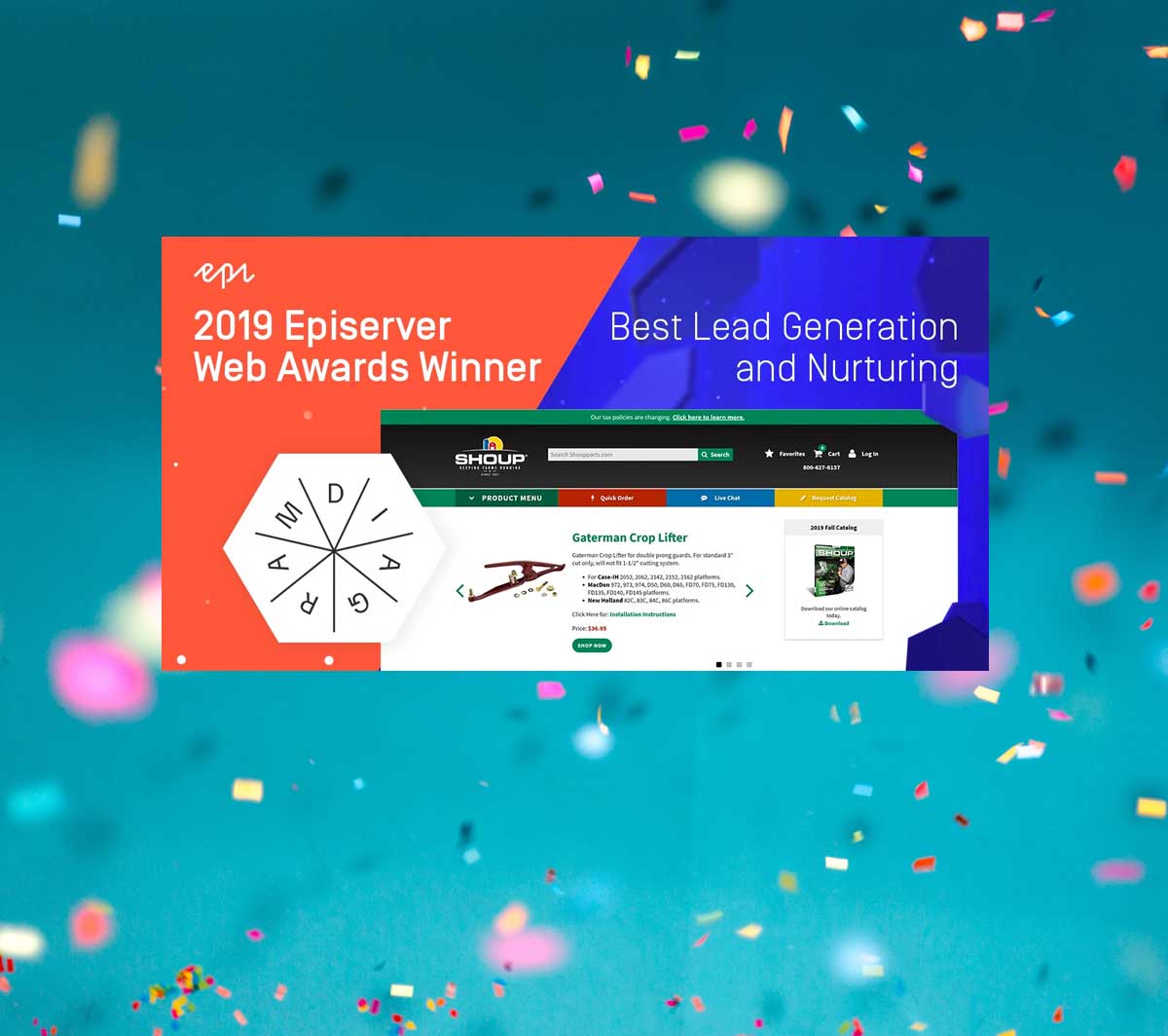How to Create an Award-Winning Web Experience
Dan Sitton#CMS, #Digital Strategy

Diagram's Dan Sitton shares how Diagram won an Episerver Ascend website award and tips to help you win at your online experience.
Creating truly successful digital experiences is not an easy undertaking and it rarely conforms to a one-size-fits-all strategy. When Shoup Manufacturing partnered with Diagram for their Episerver eCommerce website project, our mutual goal was to bring their award-winning products and customer service to life digitally. Now, over a year later and coming on the heels of the Episerver Ascend conference where Shoup's website won the 2019 Episerver Website Award for Best Lead Generation and Nurturing Website in North America, that goal was realized.
Winning an award for lead generation as an eCommerce website, normally reserved for marketing-focused websites, is a little surreal. However, implementing a customer service focused strategy that not only helped customers select the right products for their equipment but also recovered abandoned shopping carts at a rate that was four times the industry average was a key factor in this success. This inevitably resulted in explosive net-new customer growth for Shoup which exponentially increased revenue. Within just one month, Shoup recovered more revenue from abandoned shopping carts than the total cost of their entire Episerver eCommerce website implementation project.
Chris Osterhout, Diagram's SVP of Strategy, noted: "When you take the personalized experience of talking to one of Shoup's customer service team members and translate that to an eCommerce website, you have found the formula for success. It was just a matter taking that formula and applying it strategically in all facets of the customer experience".
So How Did We Do It?
Understanding that every organization is unique, and each situation has its individual nuances, is a critical first step. However, we also recognize there are many similarities in the types of problems we solve from one organization to another. With that understanding, we can implement and scale tactics that work for each customer's situation. At a baseline these tactics include:
While these ingredients for success may seem obvious, numerous nuances provide organizations the opportunity to differentiate themselves from their competitors. Sometimes these differences are subtle, but even subtle differences can impact your bottom line.
Understanding Customers
Customer Experience (CX) is more than a buzzword. Any success in business begins with understanding your customers and ends with providing value to them. We often begin our client engagements by asking the simple question of why.
- Why do your customers choose you over your competitors?
- Why do they abandon their carts?
- Why don’t they convert on content offers?
- Etc.
These questions are easy to ask but difficult to answer. One of the first keys to answering these questions is knowing how customers use the website. For Shoup, these questions helped us dive deeper into understanding why their customers were adding items to the shopping cart only to later abandon the cart. We used a combination of tactics ranging from an on-site discovery, user interviews, reviewing qualitative and quantitative website data, evaluating marketing automation information, inspecting sales data, and more. Our goal was to understand the different types of website visitors along with each user’s story. This helped build the overall narrative around why website visitors take certain actions. For example, Shoup’s customers were adding items to their cart throughout the day to review when they returned to the shop. However, they often got busy or had questions about whether the part in their cart was the correct part for their machine. What they needed was a customer-service centric approach that both reassured them that the part or parts they had in their shopping cart were the right ones for them but also a simple reminder to finalize their purchase when they were back at the shop.
Chris Osterhout, Diagram's SVP of Strategy noted: "Many organizations believe that the only way to recover abandoned shopping carts is by cutting into their margins and offering a discount. This strategy often conditions their customers to wait to purchase until they receive a discount which in most cases is both disadvantageous for the customer and the business. In the case of Shoup and many other organizations offering a discount for recovering abandoned shopping carts is not necessary as proven by the fact that Shoup is recovering abandoned carts at four times the industry average without ever offering a discount to do so."
Leveraging Data for Informed Decisions
Once we understand the customer, the next step is evaluating as many data sources that are available to determine from both a qualitative and quantitative perspective, how much value our client is offering their customers through all of their digital channels. This is done by analyzing visitor flows, page views, email marketing statistics, social statistics, CRM/ERP statistics, conversion rates, and more. If the data is not present, we work with the client to take the next steps towards gathering this information. It's critical to identify what data points you need in order to solve a particular problem. The goal with this step is to make informed decisions but also to avoid analysis paralysis.
In Shoup’s case, some of these metrics included identifying the time of day the shopping carts were abandoned and what devices were being used. It was crucial to follow that data through to when the order was finally placed by the individual customers. Often, we would see the shopping carts being populated on mobile devices but completed on desktop computers. Connecting these data silos provided important data statistics that led us to our overall strategy for abandoned cart recovery.
Integrating Technology
As with any truly customer-centric online experience technology plays a crucial role in crafting a solution. As the overall strategy becomes clear, we work with our clients to maximize the ROI from their existing technology investments. If there are gaps in the technology required to fulfill the overall strategy, or there are data silos between the existing technologies, we work with the client to close these gaps.
Shoup selected a strong CMS and eCommerce platform with Episerver but were missing key pieces related to marketing automation. As a result, we worked with them to acquire an enterprise marketing automation platform and integrated it seamlessly with Episerver. In doing so, we were able to not only tackle the abandoned shopping cart problem but also introduce overall campaign management to create the best omnichannel experience possible for Shoup's customers.
In Summary
Strong partnerships with our clients are at the center of everything we do at Diagram. Our fanatical devotion to our clients’ success doesn’t always win awards, but it regularly turns our client teams into organizational heroes. Helping our clients select, design, implement, and integrate the technology platforms needed to create personalized and contextualized user experiences is at the core of what we do every day. Being recognized for doing so is just icing on the cake.
Related Posts

Why You Need an SEO Content Audit in your Migration Plan
Diagram's Allison Casey spills all her insider SEO tips on migrating your content the right way.
![3 CMS Platform Migration Considerations [Mini Episode]](https://www.wearediagram.com/hubfs/Diagram-Views-Unfiltered-Transparent-BG-All-Black%20small.png)
3 CMS Platform Migration Considerations [Mini Episode]
Diagram's Chris Osterhout shares three essential tips that your organization should consider when moving to another CMS platform.
Results Matter.
We design creative digital solutions that grow your business, strengthen your brand and engage your audience. Our team blends creativity with insights, analytics and technology to deliver beauty, function, accessibility and most of all, ROI. Do you have a project you want to discuss?
Like what you read?
Subscribe to our blog "Diagram Views" for the latest trends in web design, inbound marketing and mobile strategy.
